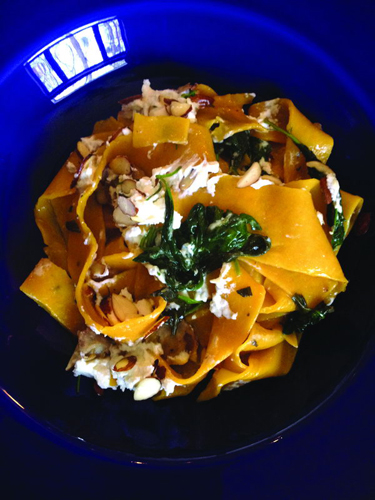.jpg)
Falling leaves and shorter days herald autumn. But to me, the most eloquent and inarguable proclamation comes from the smell of fresh sage in the kitchen. Add the richness of butternut squash, brown butter, hints of nutmeg, thyme and toasted almonds, and you have the makings of the perfect fall meal. This recipe for butternut squash pappardelle is a simple elaboration on basic homemade egg pasta. A standard hand-cranked pasta machine makes rolling out sheets of this beautiful dough a breeze. Those who do not own a pasta machine can use a rolling pin. The result will be a thicker but equally delicious result.
For this recipe, I used a vegetable stock reduction. Osem mushroom soup base with its earthy mushroom flavor (and lots of salt, so be careful), can make a lovely addition to the sauce. As with any reduction, adjust seasonings after the reduction has reached the last stage of thickening. Be careful with the salt.
Memorable and mouthwatering, this dish only seems complex. The dough can be made a day ahead. And a bit of therapeutic punching along with the kneading might be just the ticket as you brace yourself for the holiday double whammy on November 28. If you fall in love with this pasta the way I did, you might want to serve it on Thanksgiving. For a meat main or side dish, omit the Romano, butter and goat cheese and use homemade chicken stock for a rich, delectable sauce.
What You Need:
Equipment:
Large, non-stick skillet
Large pot to cook the pasta
Large bowl
Large colander
Pasta machine to roll out the pappardelle
For the pasta:
1 ½ cups cooked butternut squash, pureed
Olive oil for the pan
2 Tbs. finely chopped shallots
1 clove finely chopped garlic
1/2 tsp salt
2 Tbs. butter
1 Tbs. fresh thyme leaves
1/8 tsp nutmeg
½ cup grated Romano cheese
2 large eggs, beaten
3-4 cups all purpose flour, more for kneading and rolling
1 tsp salt
For the Sauce:
4 cups vegetable stock (no tomato; low salt)
1 Tbs. olive oil for pan
4 Tbs. butter
2 Tbs. finely chopped shallots
2-3 Tbs. white wine, optional
2 cloves finely chopped garlic
2-3 cups loosely packed, washed baby spinach
1 Tbs. thyme leaves
2 Tbs. finely chopped sage leaves
1 tsp corn starch
Salt to taste
Fresh pepper to taste
Dash of nutmeg
Dash of cayenne
For the garnish:
¼ to ½ cup toasted sliced almonds
2 ounces goat cheese
2 Tbs. chopped fresh chives
In a large, non-stick skillet, sauté the shallots until soft. Add the garlic, the butternut squash puree and the butter and cook over medium heat, stirring constantly, allowing the puree to reduce. After five minutes, add the thyme leaves, nutmeg and ½ tsp salt. When the mixture has thickened and reduced by about 40%, remove from heat. Allow it to cool, then stir in the Romano cheese.
In a large bowl, beat the eggs. Add 1 tsp salt. Blend in the cooled squash mixture. Using a fork, blend in one cup of the flour. Gradually add more flour, until a tacky dough begins to form. Transfer the mixture to a floured surface and knead in more flour until the dough becomes smooth and elastic. Knead for an additional five minutes. Wrap in plastic wrap and set aside for at least 40 minutes and up to three hours. If you make the pasta the day before, refrigerate overnight and allow the dough to sit at room temperature for an hour and-a-half to two hours before rolling it out.
Wipe out the skillet used for the squash and heat the olive oil. Add the shallots and sauté until soft. Add the wine or some vegetable stock to the pan, and, after the steam lifts, add the garlic. The garlic will soften quickly. Add 2 T butter, sage and thyme. Gradually, add the remaining vegetable stock, allowing it to reduce as you go. Since vegetable stock has no collagen, adding 1 tsp of corn starch dissolved in a little water will help thicken the sauce. Reduce the stock, adding the remaining butter, nutmeg and cayenne as you stir. When the reduction begins to coat the back of a spoon, it has reached the right consistency. Adjust the seasonings. Set the pan aside.
Divide the dough into two sections. Using the heel of your hand, flatten each section into a ½ inch oval. Feed the dough through the pasta machine from widest setting of 7 down to level 3. Repeat with the second disk. On a floured surface, cut the sheets in half and then into ¾ to 1-inch wide ribbons.
Bring a large pot of salted water to a boil. While waiting for the water to boil, heat the sauce and stir in the baby spinach. The spinach will cook down very quickly. Reduce heat to lowest setting.
Gently add the pappardelle to the boiling water. It will cook quickly. Test a piece after 2 minutes. Drain in a colander and immediately add to the pan of sauce and spinach. Shut off heat source. Gently stir to coat the pasta. Distribute the goat cheese on top, sprinkle with almonds and then the chives. Serve and enjoy!
Serves six.
By Lisa Reitman-Dobi










